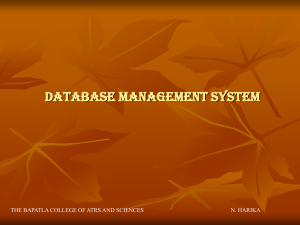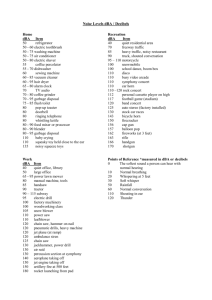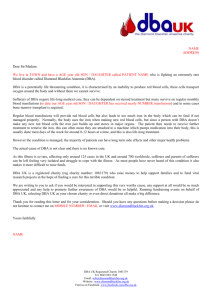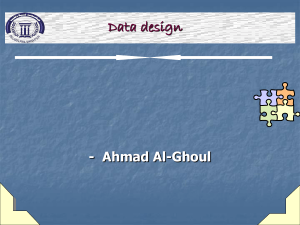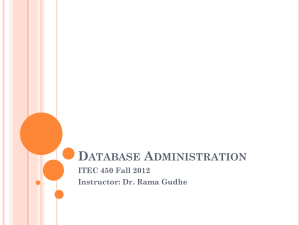DATABASE ADMINISTRATOR
advertisement
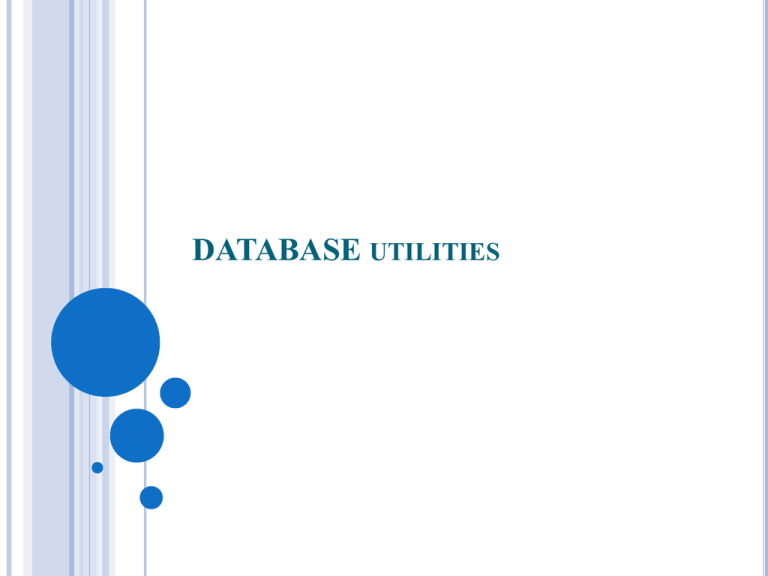
DATABASE UTILITIES DATABASE SYSTEM UTILITIES • • In addition to possessing the software modules most DBMSs have database utilities that help the DBA in managing the database system. To perform certain functions such as: Loading data stored in files into a database. Includes data conversion tools. • Backing up the database periodically on tape. • Reorganizing database file structures. • Report generation utilities. • Performance monitoring utilities. • Other functions, such as sorting, data compression, etc. • DEFINITIONS Data Administration: or data resource management is an organizational function working in the areas of information systems and computer science that plans, organizes, describes and controls data resources. Database Administration: A technical function that is responsible for physical database design and for dealing with technical issues such as security enforcement, database performance, and backup and recovery 3 DATABASE ADMINISTRATION FUNCTIONS Selection of DBMS and software tools Installing/upgrading DBMS Tuning database performance Improving query processing performance Managing data security, privacy, and integrity Data backup and recovery 4 DATABASE ADMINISTRATOR WHAT IS DATABASE ADMINISTRATOR ? A database administrator is a person responsible for the • installation configuration upgradation administration monitoring and maintenance of databases. PRIMARY ROLES OF DBA Database design Database accessibility Performance issues Capacity issues Data replication Table Maintenance DBA Tasks • Database design • Performance monitoring and tuning • Database availability • Security • Backup and recovery • Data integrity • Release migration Database design • DBA must understand the theory and implementation of the relational database management system (RDBMS) using to create the database. • Database design - needs understanding of conceptual and logical data modeling techniques. - create and interpret entity-relationship diagrams is essential for designing a relational database. • The DBA must ensure that the database design and implementation will enable a useful database for the applications and clients that will use it. Performance Monitoring and Tuning Five factors influence database performance: Workload Throughput Resources Optimization • Whenever performance problems are encountered by an application that uses a database, the DBA is usually the first one called to resolve the problem. • An effective performance monitoring and tuning strategy requires not just DBMS expertise but knowledge outside the scope of database administration. Availability • Ensure that database information is always available to all users in a form that suits their needs. • The faster the DBA can perform administrative tasks, the more available the data becomes. • The DBA must understand all of these aspects of availability and ensure that each application is receiving the correct level of availability for its needs. Security • Once the database is designed and implemented, programmers and users will need to access and modify the data. • However, to prevent security breaches and improper data modification, only authorized programmers and users should have access. • It is the responsibility of the DBA to ensure that data is available only to authorized users. DATA SECURITY, PRIVACY AND INTEGRITY User Access Management Define each user to the database Assign Passwords Define User Groups Assign Access Privileges Physical Access Control Protect and Control the Scope of the Data that is accessible to a user DBMS utilities access control Read Write Delete View Definitions Operating System Level Database Level Limit the use of query and reporting tools DBMS usage Monitoring Audit Logs Backup and Recovery • The DBA must be prepared to recover data in the event of a problem. • The majority of recoveries today occur as a result of application software error and human error. • The DBA must be prepared to recover data to a usable point, no matter what the cause, and to do so as quickly as possible. • To be prepared for any type of recovery, the DBA needs to develop a backup strategy to ensure that data is not lost in the event of an error in software, hardware, or a manual process. Data Integrity •A database must be designed to store the correct data in the correct way without that data becoming damaged or corrupted. To ensure this process, the DBA implements integrity rules using features of the DBMS. • • The DBMS relies on internal structures and code to maintain links, pointers, and identifiers. • In most cases, the DBMS will do a good job of maintaining these structures, but the DBA needs to be aware of their existence and how to cope when the DBMS fails. Controlling User Access Database administrator Username and password Privileges Users PRIVILEGES Database security: - System security - Data security System privileges: Gaining access to the database Object privileges: Manipulating the content of the database objects Schemas: Collections of objects, such as tables, views, and sequences The database administrator has high-level system privileges for tasks such as: Creating new users Removing users Removing tables Backing up tables
